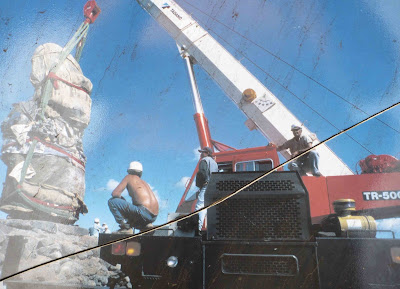Tiny Easter Island, roughly 14 mi long x 7 mi wide, is more than 2000 miles off the coast of South America and 1100 miles from its nearest Polynesian neighbor. It is the most remote inhabited place on earth. Today, the gods were feeling stormy
Despite its remoteness, it is an easy flight from Santiago to the airport on the island. The island is called Rapa Nui by its inhabitants.
Here is a basic map of the island, showing its "political divisions"
There are many famous Moia throughout the island to see, and one grouping that is probably familiar to many armchair travelers is the Ahu Akiva, which are shown in the photo here as facing the rising sun:
Near Ahu Riata, boats in the harbor:
The moia nearest my hotel:
This moia at Ahu Tangariki was the first one restored:
there are 15 moai at Ahu Tangariki
They loom impressively in the twilight
You can see them from quite a distance!
They are located quite near the bay.
A crane is raising a statue near Aku Tangariki
The moai were formed in quarries near where they were erected. Here, horses graze at the Aku Tangariki quarry:
Of course, like all famous places in the world, the souvenir vendors are close at hand!
Time out from looking at moia for a visit to Anakena Beach:
The interior of Easter Island is beautiful too ... with lots of rolling hills
If you are hardy, you can camp on Easter Island! Many hotels have made the use of their lawns possible.
Captain James Cook: in 1774, he was the third European to embark on Rapa Nui. You might enjoy reading his ship's log of his visit: https://www.easterisland.travel/easter-island-facts-and-info/history/ship-logs-and-journals/james-cook-1774/
As part of a tour of the island, you can visit the crater called Rano Kau
The make-make, or ceremonial heads, are only really seen well at museums on the island and elsewhere. Like many indigenous artifacts, they have been spirited away to museums around the world.
museum display of a moai face (above)
At Orangu ceremonial village, we learn the importance of the competitions held here:
This is an entry to a house built of slate pieces, in the village
Look closely and you'll see petroglyphs, which overlook the seabird islands
On our way back to the main village, we see a quarry for Rano Raruka; the moia is still half-buried here.
A simulated ceremony and dance performance in the village; fake but fun! Here, a painted warrior:
You want reliable transporation on Rapa Nui? Here's one choice!
A walk around lets you see local wildlife. The sea turtle: an original inhabitant. The rooster: imported by the Polynesians
How did the original inhabitants get to Easter Island. Most certainly, they navigated by the stars:
Even Moia have a lifespan. Difficult to know if they were toppled by missionaries, or as part of the continual renewal rites of old indigenous religions.
A great trip, a tropical paradise... and changing every year. Glad I got to go when I did!









































